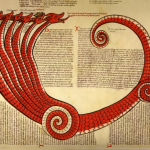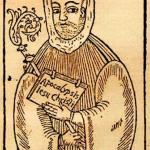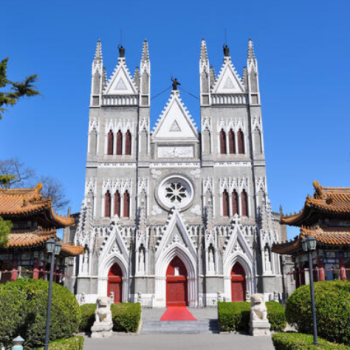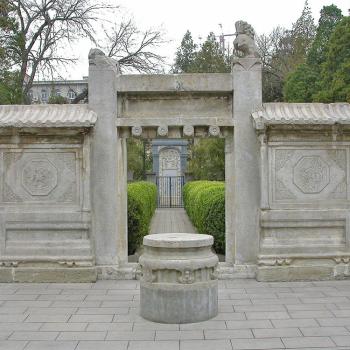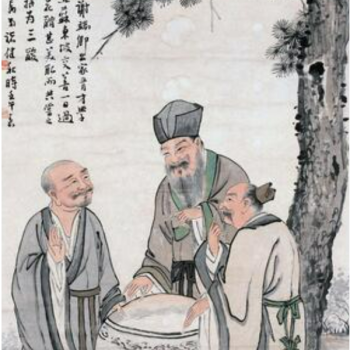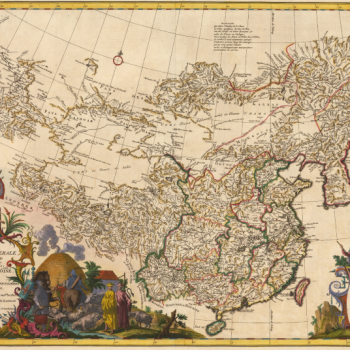“A prophet foretells the future,” as Marjorie Reeves says. “He can also create it” (135).
Her statement on Joachim’s influence remains apt. He did, of course, create the future, in more ways than one. His realization that history is a process, ever evolving, developing, and changing, introduced a revolution in human thought that transformed the medieval world into the modern one. His dream of a different and better future gave birth to countless other dreams of future improvement and progress. But if the difference between Joachim’s vision and our modern world proves one thing, it is that his influence has often been felt less in the actual substance of his ideas and more in the vistas of possibility that he opened up in the minds of others. For all the pains Joachim took to remain on the side of orthodoxy and prove his devotion to the Catholic Church, his theory of the Three Ages, with its insight that inevitable change was both a historical fact and a future hope, made possible the kinds of thinking that would eventually break that Church’s grip on the human mind and usher in a new era of intellectual development.
Joachim never fully embraced this fact. There is a conservative element in his thought that keeps his system’s more radical implications in check; he expected the Church and society as a whole to be transformed, not uprooted. However, as Reeves observes in The Influence of Prophecy in the Later Middle Ages, “Joachim’s idea of new spiritual men had a wider meaning and appeal than the Abbot could contain within his orders of monks and hermits” (Reeves 242). Joachim’s ideas proved greater than even the man himself could reckon with. Just as importantly, not everyone who came in Joachim’s wake had the same reservations about upsetting the status quo. There were many who recognized the radical potential of his system and took it as permission to develop even more radical ideas of their own. From these ideas, they developed systems of thought that fundamentally challenged the core tenets upon which medieval society was based.
Despite Reeves’s claim that Joachim’s Three Ages idea was not widely known until about fifty years after his death, it was already starting to cause a stir beyond Italy in his own lifetime. The first person to understand the theory’s radical potential was apparently Joachim’s contemporary Amalric (or Amaury) of Bène, a teacher at the University of Paris. Against Christianity’s traditional insistence that God is completely separate from His creation, Amalric preached pantheism—the belief that God is within everything, the very essence of all that exists. He found sanction for this in Joachim’s Three Ages and argued that the Age of the Holy Spirit would bring about a general recognition that God can be found everywhere and in everyone. He left behind him a sect that, while it only lasted four years after his death, actively tried to set up a rival ecclesiastical structure to the established church.
Half a century later, Gerard of Borgio San Donnino would also emerge from the University of Paris. He would argue that the coming of the Third Age meant that the Bible was now invalid and would be replaced by a new “Eternal Evangel,” a new scripture for a new era in human history. The Eternal Evangel was, as far as Gerard was concerned, Joachim’s own collected writings. Not too long after that, another Frenchman came out of the University of Paris and would prove to be Joachim’s greatest intellectual heir. Peter John Olivi’s thought was vast and complex, and included important contributions to our modern conceptions of free will and political power. Picking up on a mysterious suggestion made by Joachim that Christ would have a secret “spiritual advent” before His public return at the end of time, Olivi made a startling addition to the Calabrian’s patterns of historical repetition. He proposed that, since Jesus had been the Christ of the Second Age, a new Christ would be needed for the Third. Olivi chose Francis of Assisi for this role and went so far as to propose that, like Jesus before him, the already-dead Francis would rise again in the Age of the Holy Spirit. Olivi’s thought spread rapidly and perhaps no other individual deserves credit for making Joachim’s ideas common courtesy as he does. For this, his beliefs, like those of Amalric and Gerard, were condemned by the official Church.
The Church had good reason to be embarrassed. The University of Paris was the crown jewel of Catholic theology and yet, for some reason, it had developed the peculiar habit of producing heretics. What was more, the very school that was so famously associated with Peter Lombard—Joachim’s arch-foe—had now produced three of Joachim’s most daring disciples, men who were more than ready to use his thought to reach revolutionary conclusions about Christian doctrine itself. What was more, the Church was finding itself completely unable to curb the spread of these radical beliefs. For all its attempts at suppression, these same ideas would also begin to pop up much closer to home, in the fertile soil of Italy itself. Many unorthodox and heretical groups sprung up in the peninsula, each teaching some radical version of Joachim’s system and cherishing the hope that they might be the prophesized “spiritual men” destined to end the corrupt church and replace it with a purer kind of faith. Of these groups, one in particular stands out as more radically progressive, and thus more fascinating, than all the rest. This is the sect known as the Guglielmites.
To understand what makes this sect so unique and remarkable, it is important to acknowledge that Christianity is a very masculine faith. Its central tenet is that God was incarnated on earth not only as a human being, but specifically as a man. Jesus of Nazareth was a man on earth and, for those who believe, remains a man now that He is glorified in Heaven. The second person of the Christian Godhead is an inherently masculine figure; God, in this sense at least, is a man. Nor is that masculinity incidental to who He is; as long-cherished images such as that of the Church as a bride and Christ as the bridegroom illustrate, that manhood of God the Son has been considered an integral part of who He is, both in His own person and in His relationship to the Church.
This fact has cast a long shadow over the development of Christianity. While scholars have long speculated that a greater degree of gender equality existed in the early Church, Christianity has since that time largely been defined by the thoughts and actions of men. The apostles were all men, as were those whom they chose to succeed them. All the books of the New Testament are attributed to men. The great theologians of the young faith and the earliest doctors of the Church were men. Many remarkable women have existed throughout Christian history, but time and again they have been overshadowed, overlooked, and disregarded by the men who have chiefly directed the course of Christianity’s development.
This has affected both Christian doctrine and the structure of the Christian Church. St. Paul forbid women to preach or prophesy and insisted upon their submission to their husbands. The roles that women could play in religious communities were severely curtailed after the first century. By the end of the second, the Montanists were branded heretics for continuing to acknowledge female prophetic and religious authority. Since those days, the Catholic Church has resolutely opposed female ordination on the grounds that Jesus did not include any women amongst His apostles. Most other churches have historically followed suit, barring women from the ministry, and female pastors remain a point of contention in Christianity today. Christian traditionalists continue to call for women to remain subservient to the men in their lives for both their physical and spiritual welfare. This sentiment was even more pronounced in Middle Ages, where women sat at the bottom of the spiritual as well as the social hierarchy. Women were believed to be more prone to bodily sins—particularly lust—and to errant beliefs than men were. Thus, religious authorities demanded that they be kept under strict and constant supervision. Even autonomous religious bodies such as convents fell under harsh scrutiny by the male-ruled Church, which emphasized the need for nuns to be obedient to their male priests. And while the occasional remarkable woman, such as Hildegard of Bingen or Brigid of Sweden, could make herself heard, the Church did its best to silence women’s voices in all matters of revelation, doctrine, and religious debate.
But what if it could have all been different? What if women, alongside men, had been the chosen officials of God and God’s Church? Or, to go even further, what if God had been a woman? These were the questions that the Guglielmites posed to the medieval world. Taking the ideas espoused by the likes of Amalric, Gerard, and Olivi as their starting point, this remarkable sect would go even further than any of those thinkers . For the Guglielmites would embark on the first comprehensive attempt to remake Christianity on a more inclusive and feminine basis.
The year was 1262. The place was the city of Milan. Expectation was in the air. Joachim’s theory of the Three Ages, and the promise of a coming age of progress and spiritual peace, was now truly a hot topic throughout the Italian peninsula. Some of Joachim’s less cautious followers had decided to set a date on the coming of the Third Status. Joachim himself, despite what is often claimed, did not—“we may not at all know the number of days or months of those generations” (Lib. Con. 2.1.21)—but many others were eager to speak for him. They said it would arrive in 1260, and this became the commonly accepted date for the beginning of the new age. That the new age did not arrive right on schedule did very little to dampen popular expectations. The Holy Spirit’s reign was coming, everyone said, any day now.
Into this heady climate of hope and optimism stepped a fifty-some year-old woman, with her adult son in tow. Of her son, history took no further notice. But the woman herself was a different story. She told those who gathered around her that she was a daughter of the King of Bohemia. Others said that she had crossed the sea from England. She claimed to have been born on Pentecost, the Christian feast that celebrates the descent of the Holy Spirit. That would prove significant. She said that she had been born with one name but had since changed it. Her new name, the name her followers knew her by, was Guglielma.
Guglielma was, needless to say, a woman of mystery, a woman who could seemingly be all things to all people. As Barbara Newman puts it in “The Heretic Saint: Guglielma of Bohemia, Milan, and Brunate,” Guglielma “was already one of those mysterious, spellbinding figures whose destiny is to attract the powerful projections of others, for better or worse” (Newman 3). Maintaining a house in the city, Guglielma soon gathered a number of disciples around her, both men and women, and from all classes of society. She modeled this ragtag group into something like a monastic order, in which everyone shared a common life and dressed in a simple, brown habit. Newman describes her activities during this time: “She warned merchants to avoid usury and fraud, as any religious person might have done; comforted the sorrowful; prayed for the sick and was credited with healings” (Newman 11). Guglielma’s leadership of her own religious community would not have been looked upon favorably by the Church, and her healings would be even more suspect, but everything from her outward life seemed to indicate that she was otherwise an orthodox and respectable, if eccentric, woman of faith.
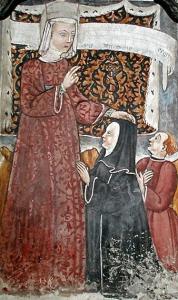
But there was more going on behind the walls of Guglielma’s home. Amongst the privacy of her closest disciples, a new doctrine was beginning to take shape. Her claim to have been born on Pentecost, the day that marks the descent of the Holy Spirit to earth, gave a hint of its contents. So too did the marks of the stigmata that had appeared on her hands and feet. The final, most revealing clue was her heady statement that “from the year 1262 onward, the body of Christ had not been sacrificed alone, but along with the body of the Holy Spirit, which was Guglielma herself” (qtd. in Newman 12). From her words and these special signs, her most prominent disciples came to a startling conclusion: Guglielma was telling them that she was herself the Holy Spirit, the third person of the Godhead, come in the flesh, as God the Son had done before her.
Marjorie Reeves offers a convenient summary of Guglielma’s teaching, “The main tenets … were quite unambiguous: they declared that, as the Word had been incarnate in a Man, so too the Holy Spirit had become incarnate in a woman, Guglielma. She, too, would rise from the dead, ascend into heaven in the sight of her disciples, and send unto them the Holy Spirit as tongues of flame” (Reeves 249). The new doctrine of the sect was that Guglielma was God. But there was more to it than that. In Christianity, it is God in the person of the Son whose role is to come down as Jesus of Nazareth for the sins of humanity. Guglielma did not claim to be the Son nor did anyone claim this for her. Instead, her role—an entirely unprecedented one—was that of the Holy Spirit, taking human form just as the Son once had. This created a unique dynamic between the Son and the Holy Spirit.
This was a new and remarkable understanding of the relationship between these two persons of the Godhead, making them into complimentary forces who fulfilled similar roles in the work of human salvation. Joachim had hinted at something like this when he spoke of their joint procession from the Father and of the Second Age as being “assigned to the Son and the Holy Spirit together” (Lib. Con. 2.1.9). But he surely never meant his words to extend as far as the Guglielmites took them. And yet, this new formulation applied logic that was already inherent in his system of the Three Ages. For, if the Three Ages are to be identified by the parallels that recur in each age, and if the defining element of the Age of the Son had been the incarnation of the Son Himself into the world, does that not mean that there needs to be a parallel incarnation in the Age of the Holy Spirit? And would it not be most appropriate for the Holy Spirit to incarnate in Its own age, just as the Son had done in His? In this fashion, the Guglielmites were able to reason that the Calabrian’s own ideas necessitated a second incarnation of God, and of another member of the Godhead, in human history.
But that was not all that necessitated this new incarnation. The matter of gender was also paramount. God incarnating as a man had created an imbalance. Genesis says that “God created human beings in his own image; in the image of God he created them; male and female he created them” (Gen. 1:27). God needed to have both a masculine and a feminine aspect in order that all could be made in His image and be united in Him. But now, only men could see themselves as being in the image of God, for he had only been made visible in a man. Half the species had been privileged with being of the same gender as God, been empowered by the fact that Jesus shared their sex, while the other half had been separated from Him and subjugated because of it. For everyone to brought back into union with God, for salvation to be fully worked out, the balance had to be restored. As Newman remarks, “Guglielma herself was not so much a successor to Christ as his exact female counterpart” (Newman 15). God had to be visible as a woman to complete the work He had begun as a man. Making the Holy Spirit female allowed Jesus’s masculinity to remain while still having the genders united in the Godhead; in the Trinity, male and female could coexist, being distinct but united in a perfect whole.
This had profound ramifications, not just for Christian doctrine but for the structure of the Church itself. As Reeves explains, “Once more the extreme implication is worked out: all authority has departed from the existing ecclesiastical hierarchy and Boniface VIII is no true pope. Once more the new spiritual roles are allotted, this time to women, for Manfreda [sic] will be the new pope and her cardinals will be women” (Reeves 249). Guglielma imagined nothing less than a complete gender reversal in the structure of the Church. Women would now occupy positions of power, administration, and ministry to make up for the fact that they have previously been held exclusively by men. This did not mean only the women would be preachers and pastors. It extended all the way to the top of the Church hierarchy. Among Guglielma’s followers was Maifreda (not Manfreda) da Pirovano, an Umiliate nun who hailed from the powerful and aristocratic Visconti family. Guglielma chose Maifreda to be the first female pope. A poor seamstress named Taria Pontario was, despite her lowly position in life, made a cardinal. The Church of the future would be as free of class discrimination as it would be of sexism.
Even as women took over the leadership roles, men would not be barred from them, as women were when men ruled the Church. One of Guglielma’s most important followers was Andrea Saramita, who codified her doctrine and may have been the first to suggest that she was God. He was a man, and his prominence suggests that men were expected to occupy positions of power and authority even in the new female Church. What was being worked out was a model of ecclesiastical equality, where everyone, no matter their sex or position on the social ladder, had a chance to take on a high religious role. No one would be discriminated against due to their gender or social class, as all would be equal in the Church. Joachim’s desire for a less hierarchical Church had found a new and strikingly modern form. Under the sect’s watch, his roughly egalitarian ideal had been transformed into something very much like our modern notion of equality, greatly expanding upon his original vision of a better and fairer world.
It was a world that Guglielma herself would never get to see. She passed away nearly twenty years after her arrival in the city, in 1181. Her death did not do much to hinder her devotees’ enthusiasm. If anything, they threw themselves even more ardently into creating their new church and a new kind of religion to go along with it. As Newman notes, “The movement’s theology took a typological form inspired by Joachite ideas: just as the New Testament had superseded the Old, devotees set about composing their own epistles, gospels, and prophecies that would eventually supersede the New” (Newman 15). The Guglielmites were very productive, readying both a new church structure and a wealth of devotional literature for the time when they would be called upon to remake Christianity. Maifreda, with Andrea by her side, took the reins of the new little church, becoming the new leading woman and central figure of the Guglielmite movement. She had been appointed pope by Guglielma and was now determined to reign as such. In this one city in Christendom, among a small group of secret believers, the Pope was now a woman.
Our times have seen a popular resurgence of the medieval “Pope Joan” legend, which tells of how a daring and learned woman disguised herself as a man and was elected pope. The idea of a female pope seems to strike a chord with moderns, whether because they like its implications for equality—despite the legend being highly misogynistic in its original form—or because of the embarrassment it would cause the “old boys’ club” that is the Catholic hierarchy. But despite how popular the Pope Joan story has become, it is generally held to be false by specialists. Scholars have long since picked it apart and found no truth in its incredible assertions. There is just not enough evidence to suggest that a woman ever occupied the chair of St. Peter in Rome.
But there was, for about two decades at the end of the thirteenth century, a female pope. Or, at least, there was a woman who actively claimed to be pope, who took on the role of pope for her followers, and who reigned as pope over a church. A woman who was, in her own mind at least, in direct contention for the throne of Peter. That woman is Maifreda Visconti, the Pope of the Guglielmites. Her authority may have only extended to her sect of believers and she will never be included among the official list of pontiffs recognized by the Catholic Church. But she was, for all those who believed in Guglielma as the incarnation of the Holy Spirit, the true Vicar of God on earth. And, for a brief moment in 1300, she did have a chance of getting that claim accepted by the powers-that-be in the city of Milan.
As noted, Maifreda took control as la papessa immediately upon Guglielma’s death. She ruled the sect for nineteen years, the same amount of time Guglielma herself had. She and Andrea worked together to take what they had gleamed from Guglielma’s gnomic and often contradictory remarks about being the Holy Spirit and turn it into a functioning theology. The mature Guglielmite system described above, with its striking parallels to Gerard and Olivi, its new scriptures and need for an exact female parallel to Christ, was their doing. Indeed, they went so far, as David Burr documents in “Olivi, Maifreda, Na Prous, and the Shape of Joachism, ca. 1300,” to claim that “Guglielma, like Christ, would be – in fact had been – resurrected, was appearing to various disciples, and would eventually ascend into heaven” (Burr 282). By claiming that Guglielma was still among them, and by casting Maifreda as the Peter to her Christ, the duo was able to successfully keep the community together for two decades. Luck smiled on them for a while; while papal inquisitors took note of them soon after Guglielma’s death, outside events prevented the Church from taking decisive action against the sect until the year 1300.
In that year, a confluence of factors led to the full might of the inquisition coming down on the heads of Maifreda and her sect. Not long before, in 1296, Pope Boniface VIII had decided to begin a crackdown on women who preached and carried out priestly duties. Also by 1300, the Dominicans—ironically, one of the two monastic orders whose coming Joachim was believed to have foretold—had come into their own as the domini canes (dogs of the Lord), implacable hunters of heresy with a special mandate from the Holy See that let them cut through the slow-moving bureaucratic processes of the inquisition and deliver results. But perhaps the most decisive factor was that, in 1300, Maifreda decided to make her bid for the papacy public. Previously, her papal role had been exercised only in the safe confines of her convent at Biassono. As Newman describes it, “There Sister Maifreda held undisputed sway, performing audacious priestly actions that included anointing devotees with the holy water in which Guglielma’s relics had been washed; blessing and distributing hosts that had been consecrated at her tomb; preaching to her sisters and lay devotees about the Gospel and the saints” (Newman 14). But in 1300, Maifreda went a step further. She donned papal vestments and performed a Mass for the first time. Even if the attendees at the Mass were all Maifreda’s disciples, it was still a public declaration that she saw herself as the pope and intended to act as chief vicar and supreme pontiff of the Christian Church.
Why did Maifreda act now to make her claim public when she had kept it secret for nearly twenty years? As Burr observes, “Maifreda must have recognized that even if her claims about Guglielma’s impending public ascension proved true … in the meantime those who anticipated it with bold actions (like a woman conducting mass) would be extremely vulnerable. In fact testimony shows that she did recognize it” (Burr 283). What, then, could have caused her to throw caution to the wind as she did? Perhaps it was faith. She seemed to really believe that Guglielma’s moment of ascension was drawing near, bringing the Third Age and the Church’s complete transformation with it. And yet, there might have been another reason Maifreda began to proclaim her pontificate more openly at this time, a reason far more political and pragmatic than accounts of her as a hopeless fanatic would suggest. Perhaps she acted now because she sensed that she had a chance of making good on her claim.
As noted previously, Maifreda was a child of the powerful and influential Visconti family. Her cousin Matteo had spent the last decade consolidating power in Milan and by 1300 was its absolute ruler, founding the Visconti line that would control much of northern Italy for the next century and a half. Newman remarks, “Matteo Visconti in 1300 appeared to be at the apogee of his power” (Newman 18). Matteo was also no friend of the Papacy, now soundly ensconced in Avignon, and would spend the next few decades openly at war with the Holy See. Given her close connections to the lord of the city and his animosity toward the current Papacy, Maifreda might have believed that Matteo would support her attempt to set up a new papacy, with her as pope. Perhaps she hoped that he would lend his considerable political and military power to the effort. She probably thought he would at least be able to shield her from the wrath of the inquisition. She certainly had every reason to think that he would look kindly upon her efforts.
And perhaps he did. When Matteo himself was tried in absentia for heresy by the Holy See, in the midst of his long war against them, one of the charges was that he had actively conspired with Maifreda in 1300. Pope John XXII accused Matteo of an all-out assault on the ecclesiastical order of the church, as Newman summarizes, “Among other things, Matteo is accused of violently arresting and detaining clerics, interfering with the pope’s messengers, ‘impeding the office of the inquisition’ in many places, imprisoning the bishop of Vercelli, imposing unlawful taxes on churches, intruding unworthy persons as superiors of religious houses, disrupting a crusade sermon, and bribing Saracen kings to take arms against John XXII” (20). With regards to Maifreda, Matteo was charged with interfering heavily in the inquisition’s investigation of her activities. Pope John accused him of suppressing much information about the Guglielmites’ activities and intervening to save the highest-ranking members of the sect from execution. He was said to have made Maifreda’s closest associates his councilors and to have maintained a close friendship with Fra Dolcino, the leader of a different sect based on Joachim’s ideas. Matteo’s son and eventual heir Galeazzo—who continued his father’s relentless war with the Papacy—was alleged to be one of Maifreda’s most devoted disciples. Matteo apparently went so far as to try and save Maifreda herself from execution.
As these are charges made by Matteo’s adversaries, they may be fabricated or exaggerated. But Newman, at least, finds them credible and thinks that Matteo did provide some support to his cousin’s effort in 1300. However, he was not yet at open war with the Papacy and thus there was only so much even he could do. While several high-ranking members clearly did manage to avoid execution, the two ringleaders were not so lucky. Maifreda had already worn vestments and celebrated the Mass. This marked her as a both an unrepentant heretic and an open papal pretender in the eyes of her Dominican inquisitors. There was no escape for her, or for her Andrea Saramita, who had done so much to establish the sect’s doctrine. They were both executed. The dream of a female-led church, of total equality between the sexes in religious matters, died with them.
It is tempting to think that if Maifreda had managed to survive just a few years later, she might have found more success. True, she would never have been established in either Rome or Avignon. But one has to wonder if, once warfare erupted between the Visconti and the Papacy, she could have established herself as a credible antipope exercising religious authority over large swaths of northern Italy. And yet, it seems hard to imagine that Matteo Visconti, a shrewd and calculating ruler, would have given his full backing to a project so antithetical to the beliefs and opinions of most Christians. As Burr notes, in sentencing Maifreda to death, “the inquisitors were condemning as heretical an expectation most medieval Christians with any understanding of theology as then practiced would have rejected” (Burr 288). It is reasonable to think that, even under the best of circumstances, Matteo would have balked at carrying out Maifreda’s program for the installation of herself as pope. Given the general misogynistic climate of the Middle Ages, Pope Maifreda’s larger ambitions were simply unattainable without the divine intervention she was waiting for, and Matteo himself would surely recognize that.
Against this, however, it seems that the Visconti dynasty would long afterward maintain a positive view of both Guglielma and Pope Maifreda, and this included taking the latter’s claim to the papacy at least somewhat seriously. If they were indeed as devoted to Maifreda as Pope John alleged, her death could have been a reason for the early Viscontis’ undying hostility toward the popes. Perhaps, in their own way, they were continuing her program of tearing down the old church. In addition, despite the fact that Guglielma had also been posthumously condemned for heresy, with her body dug up and burnt, she remained a popular figure in the region. Newman records that she continued to be revered in Ferrara—which Galeazzo Visconti made his base for a few years—and came to be venerated as a saint, even if the details of her life and her extraordinary claim to Godhood were quickly forgotten.
She became the subject of a popular play in the 1490s, though by this time, her actual story had been replaced by a traditional saint’s life and no longer contained any trace of heresy. After this, she would have a curious afterlife, coming to be venerated in many stringently orthodox monastic houses—including, in a pleasing bit of irony, among the Dominicans—in northern Italy. Brunate became the center of her veneration and a painting in the church of San Andrea would show her in the company of St. Vincent Ferrer, the man who rechristened Joachim’s Third Age as the “Age of Aquarius,” with the painter apparently unaware of these two figures’ dangerous associations. The orientalist Richard Burton even mentioned her in a footnote to his landmark edition of the Arabian Nights, noting her merely as a local saint who cures headaches. Her popular veneration has survived into modern times, with the Bishop of Como issuing a prayer in her name in 1912. In the end, the same Church that burned Guglielma’s bones welcomed her back with open arms and never realized their mistake. She was popularly—though never officially—declared a saint, gaining legions of devoutly orthodox admirers who never suspected that the object of their pious and proper adoration had suggested herself to be God the Holy Spirit and the equal of Christ Himself.
Maifreda never reached this level of popular veneration. Even so, her claim to the papacy has survived in a few surprising ways. There is, of course, the Pope Joan legend. Despite being the closest thing to a female pope that has ever existed, Maifreda is not generally credited as the inspiration for this character. Pope Joan’s life story does not align with hers at all, though the traditional detail that Pope Joan came from England and immigrated to Italy matches up closely with one account of Guglielma’s own origins. Indeed, the legend itself seems to have first been recorded a few years before Guglielma appointed Maifreda as pope, though most of the finer details beyond the basic outline had yet to be worked out. Still, the legend seems to have emerged from the same anti-papal, Joachim-tinged milieu that also created the Guglielmites.
As Thomas F. X. Noble notes in “Why Pope Joan?,” “Joan’s story emerged among Dominican and Franciscan authors in the last decades of the thirteenth century … This was a period when controversy wracked the orders, when papal decisions for or against positions dear to one order or the other were causes for joy or consternation and when the abdication of Celestine V and the election of Boniface VIII called the legitimacy of the papal office itself into question” (Noble 230). The trouble in the mendicant orders that Noble obliquely refers to was the struggle between the Joachimite Spiritual Franciscans and the Conventuals over the direction of the order, a feud the popes were all too happy to intervene in. Meanwhile, Celestine V had widely been expected to be Joachim’s Angelic Pope, and his short pontificate and the apparent usurpation of Boniface caused many—including, scholars think, Guglielma and Maifreda—to question the legitimacy of the current ecclesiastical authority and turn to more radical interpretations of Joachim’s ideas. Thus, the legend of the female pope and the actual female antipope were both products of the climate of Joachimist spiritual dissent that had spread across Italy. Given this, some folk memory of Guglielma, Maifreda, and their radical plan for a female church could have left an imprint on the emerging Pope Joan legend, providing some details (like the supposed English origins) and helping the legend become as popular and intractable as it soon did.
Maifreda’s influence is also felt in another unexpected place. Everyone who is familiar with tarot cards will immediately recognize the card of the High Priestess. Most will also know that, before the now-standard Rider-Waite deck came along and stripped the cards of their Catholic references, the High Priestess was known as “The Papess/Popess,” a female pontiff who acted as the counterpart to “The Pope,” the card now known as the Hierophant. Many who wonder about the origins of this card assume that it must depict Pope Joan. Newman points out that this identification is untenable, “The mysterious card was once assumed to represent the Pope Joan of medieval legend, but its iconography does not fit Joan, who had never been a nun” (Newman 28). Rather, as Newman documents, the Papess or La Papessa first appears in the Visconti-Sforza Tarot deck which is, incidentally, the ultimate source of all modern tarot decks as it is the first to contain the now-standard set of cards.
That this deck bears the Visconti name is suggestive, since Maifreda was herself a Visconti and enjoyed the patronage of her cousin, the first Visconti lord of Milan. Indeed, as it turns out, this tarot deck was commissioned by the last of the Viscontis, Bianca Maria. Bianca Maria, the final Visconti ruler of Milan and co-founder of the succeeding Sforza dynasty, was the direct descendant of Matteo, Maifreda’s cousin and ally, and of Galeazzo, her devoted supporter. Maifreda was thus one of the founding generation of Viscontis to whom Bianca Maria owed her own position. The fact that La Papessa is a female pope dressed in the habit of a nun—as Maifreda would have, since she was indeed an Umiliate nun—suggests that Bianca Maria did not forget that a previous woman in her family had also striven for great power and chose to honor her remarkable ancestor by including her among the cards of her new tarot deck.
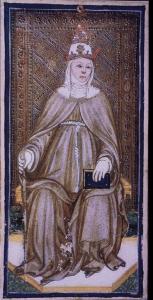
Bianca’s family connection to Maifreda and the latter’s role in the founding generation of her dynasty help to explain why she had Maifreda depicted as the Popess of the card. But Newman has found an even stronger connection. In “The Heretic Saint,” she demonstrates that Bianca had an active interest in Guglielma and the sect she founded, which Maifreda ruled over as Pope, “his [Matteo’s] last lineal heir, Bianca Maria, not only commissioned the Visconti-Sforza tarots but also brought the cult of St. Guglielma to Brunate, where an image of the ‘true Holy Spirit’ with her martyred apostles remains to this day” (Newman 30). Bianca Maria was directly involved in and contributed to the revival of interest in St. Guglielma that occurred in the latter half of the fifteenth century. She took a special interest in the nunnery of San Andrea in Brunate and acted as its royal patron, maintaining a close relationship with its abbess and intervening on its behalf with church authorities. It was she who convinced the nuns at Brunate to adopt St. Guglielma as their special patron and she even commissioned a joint portrait of Guglielma, Maifreda, and Andrea Saramita that still stands in the church today.
That Bianca had all three painted together indicates that she both knew the details about the Guglielmite sect and thought it worth commemorating. She took not just Guglielma and Maifreda’s memory but their claims and achievements seriously. After all, the remarkable thing about La Papessa is that Maifreda is depicted as the female pope she considered herself to be. She is even allowed the royal accoutrements of the papacy, such as the triple tiara and throne, that she never could enjoy in life. Bianca’s tarot leaves no doubt: Maifreda was a pope, deserving of papal glory. The image in the Visconti-Sforza tarot, like that at San Andrea, is a vindication of Guglielma, Maifreda, and what they believed about women’s roles in the Church.
This means that Bianca must have not only taken Maifreda’s claim to the papacy seriously but also have cherished it—indeed, perhaps all the Visconti rulers of Milan did. This is all the more remarkable because, unlike her quarrelsome ancestors, Biance Maria maintained excellent relations with the Papacy and projected a front of unimpeachably orthodox piety. Yet despite her own reconciliation to the male-dominated ecclesiastical structure of her times, she still thought highly enough of Maifreda’s dream of a female-led Church to inscribe it forever within the cards of the tarot. The nun-pope of Bianca’s tarot is Maifreda Visconti and thus so too are the future female popes and high priestesses of all subsequent tarot decks. The very image of La Papessa—and its disguised successor—the High Priestess, has kept the idea of female religious authority alive for generations, ensuring that, in a certain manner, the dream of Maifreda and the Guglielmites lives on.
This is not, however, the only means by which their beliefs and ideals have outlasted them. As noted above, the Guglielmites were firmly rooted in the Joachimite tradition. They took Joachim’s concept of a transcendent Age of the Holy Spirit and his belief in historical repetitions, mixed in Olivi’s claim about the coming of a new Christ to ring in that age and the kind of new church ambitions so dear to Amalric’s disciples, and finished it all off with Gerard of Borgio San Donnino’s notion of a new testament to replace the Bible. They believed in the peaceful reconciliation of all faiths and the gradual revelation of new spiritual knowledge. In this sense, they resembled the general body of Joachim’s more radical disciples at the time and were particularly similar to Olivi. As Burr notes, both Olivi and the Guglielmites build their theories on a particular application of Joachim’s recurrence principle: “The transition from second to third age mirrors that from first to second, and we can assume that the parallel will include recognizable similarities uniting the two axial figures, Christ and Francis or Christ and Guglielma” (Burr 286). But for all their similarity to other radical Joachimites, the Guglielmites did add something new to this matrix of beliefs.
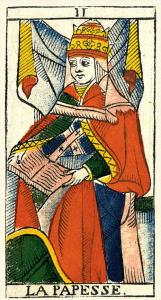
That new thing was that God could be a woman, or at the very least that God the Holy Spirit needed to be female in order to balance the masculinity of God the Son so that men and women could both be made in God’s image. The Guglielmites were the first to introduce a concept of the feminine divine into Christianity. They would certainly not be the last. A quarter-century after Maifreda’s execution for heresy, the inquisition discovered another female preacher emboldened by the Holy Spirit who owed a debt to Joachim. Na Prous Boneta was a devout follower of Olivi who believed that she was the vessel in whom Christ would suffer again and by which the Holy Spirit would establish the Third Age. It was she that made another radical leap; in her thought, the Christian covenant will not simply be perfected in the new age, but actively replaced, as Christ’s covenant had replaced the old covenant before him. Thus she was, perhaps more than any of her predecessors, moving toward not just a reformed Christianity but a new religion entirely.
Nor was Na Prous the last woman to shroud herself in eschatological purpose and possible divinity. Several women through the ages have done so, often in terms very reminiscent of Guglielma. The Shakers say that their founding mother, Ann Lee, had proclaimed herself the second Christ and the female part of the Godhead. Joanna Southcott called herself the Bride of Christ, the vessel of the Holy Spirit’s new revelations, and the mother of the Christ to be. Recent times have produced women who, very much like Guglielma, have claimed or been claimed to be the Holy Spirit incarnate; this list includes both Maria Franciszka Kozłowska of the Mariavites and Juanita García Peraza of the neo-Joachimite Mita movement. Even male theologians have gotten in on the act; Count Zinzendorf, founder of the Moravian Brethren, insisted that the Holy Spirit was the female aspect of God, just as the Guglielmites had. Jacob Boehme, in many respects a latter-day Joachimite, similarly declared that a female counterpart to Christ, named “Sophia,” existed in the Godhead. This complex of ideas continues to attract interest in modern times, finding fertile soil in places like China, where churches professing these notions can be traced back to at least the early twentieth century. Perhaps we might even consider modern efforts to find traces of goddess worship and the divine feminine in Christianity as successors to the project begun by Guglielma of Bohemia and Pope Maifreda over seven centuries ago.
It is evident, then, that while the specific hopes of the Guglielmites never came to fruition, their greater effort to give God a female face lives on. Every later step in that direction and everyone who expresses dissatisfaction with the relentlessly masculine focus of Christianity is treading the path already paved by Guglielma, Maifreda, and Andrea Saramita. What is clear, then, is that the Guglielmites are responsible for an incredible new advance in the field of theology. Their fundamental question, “What if God is a woman?” is one whose implications have reverberated throughout history. In our own times, as Christianity is forced to change and evolve in ways previously thought impossible, the question is becoming all the more pressing.
All this, it must be said, takes us back to the influence of Joachim. It is true that the sage of Calabria himself never would have ventured the idea that God, or a part of God, might be female. And yet, that was the implication which the Guglielmites believed lay at the heart of his system, within his promise of an Age of the Holy Spirit, his patterns of historically-repeating personalities and events, and his hopes for a fairer, more equitable church. Nor were they the last to think so; Joachim’s thought has repeatedly fostered hopes for a Church that welcomes female participation, acknowledges female authority, and perhaps even recognizes a female aspect of the Godhead. As this so amply demonstrates, a large part of Joachim’s legacy consists of the ideas that he inspired in others. The abbot prophesized wiser than he knew. When he was not willing to take his insights as far as they could go, others came along to do so. In some cases, this produced new insights that were inspiring, inventive, and surprisingly modern. This was certainly the case with the Guglielmites. It was their radical rereading of Joachim, and their understanding of the potential latent within his ideas, that for the first time gave the Christian world a glimpse of the feminine face of God.
Works Cited
Burr, David. “Olivi, Maifreda, Na Prous, and the Shape of Joachism, ca. 1300.” Franciscan Studies, vol. 73 (2015): pp.275-294.
Genesis. The Oxford Study Bible, edited by M. Jack Suggs, Katharin Doob Sakenfeld, and James R. Meuller. New York: Oxford University Press, 1992. pp. 11-61.
Joachim of Fiore. Liber de Concordia Novi ac Veteris Testamenti, edited by E. Randolph Daniel. Transactions of the American Philosophical Society, vol. 73, no. 8 (1983): pp. 1-455. All translations mine.
Newman, Barbara. “The Heretic Saint: Guglielma of Bohemia, Milan, and Brunate.” Church History, vol. 74, no. 1 (March 2005): pp. 1-38.
Noble, Thomas R. X. “Why Pope Joan?” The Catholic Historical Review, vol. 99, no. 2 (April 2013): pp. 219-238.
Reeves, Marjorie: The Influence of Prophecy in the Later Middle Ages: A Study in Joachimism. Oxford: Clarendon Press, 1969.

